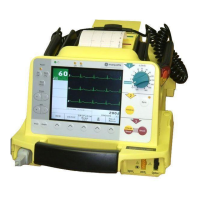Pacemaker
38 Marquette Responder® 3000 227 490 02-C
Warning
Shock Hazard — During pacing set the energy
selector to to prevent that a defibrillation
pulse is triggered inadvertently.
On
Off
Start
Pause
+ —
Dem
Fix
P/min
+ —
mA
Pacer
19
20
21
22
25
24
Figure 6-1. Pacemaker operating controls
19
Button to change the pacer cur-
rent output
20
Button to change the pacer rate
21
Button to pause the pacer func-
tion (settings remain stored)
22
Button to toggle between demand
and fixed-rate pacing
24
Button to enable and disable the
pacemaker
25
Indicator is illuminated when the
pacemaker is on and goes off briefly
with each delivered pacer pulse
Demand Pacing
Caution
: The pacer pulses are delivered via the
adhesive defibrillation electrodes which must be
applied as described in chapter 4.
Separate electrodes must be applied for acquisition
of the ECG signal (chapter 7).
The pacemaker can be enabled only when adhesive
electrodes are connected.
In demand mode, the pacemaker does not deliver
pacing pulses as long as the patient's intrinsic heart
rate exceeds the set pacing rate. When the heart
rate drops below the pacing rate, the pacemaker
starts emitting stimulation pulses. This can only be
ensured by continued electronic monitoring of the
ECG. The necessary synchronization pulses are
automatically sent to the pacemaker.
The demand mode is the recommended pacing
mode when the patient is at risk of developing
bradycardia or even cardiac arrest as a result of a
critical event. As the pacemaker function is
controlled by the patient's ECG, the harmful
competition between intrinsic and external
stimulation which could induce ventricular
fibrillation is excluded.
•
Check that the ECG electrodes and the pace
pads are correctly applied and connected to the
device.
•
Press
On
Off
(
24
, Figure 6-1) to turn on the
pacemaker.
The device defaults to the Demand mode and
selects a pacer rate of 60 P/min (configurable)
(Figure 6-2).
Caution
Interrupted Arrhythmia Monitoring — Arrhyth-
mia monitoring is disabled while the pacemaker is
operating.

